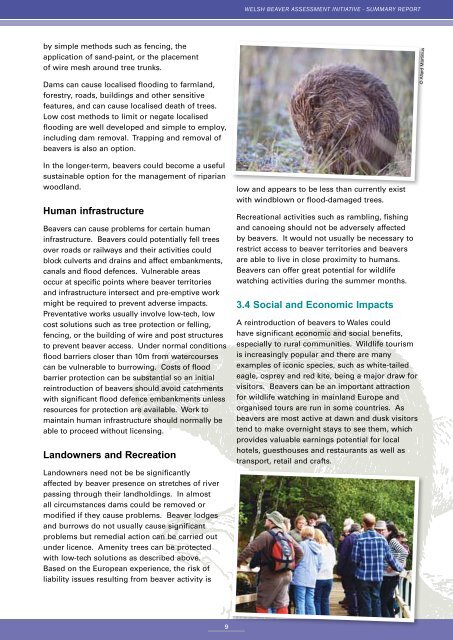Beaver-Summary-report-English
Beaver-Summary-report-English
Beaver-Summary-report-English
Create successful ePaper yourself
Turn your PDF publications into a flip-book with our unique Google optimized e-Paper software.
y simple methods such as fencing, the<br />
application of sand-paint, or the placement<br />
of wire mesh around tree trunks.<br />
Dams can cause localised flooding to farmland,<br />
forestry, roads, buildings and other sensitive<br />
features, and can cause localised death of trees.<br />
Low cost methods to limit or negate localised<br />
flooding are well developed and simple to employ,<br />
including dam removal. Trapping and removal of<br />
beavers is also an option.<br />
In the longer-term, beavers could become a useful<br />
sustainable option for the management of riparian<br />
woodland.<br />
Human infrastructure<br />
<strong>Beaver</strong>s can cause problems for certain human<br />
infrastructure. <strong>Beaver</strong>s could potentially fell trees<br />
over roads or railways and their activities could<br />
block culverts and drains and affect embankments,<br />
canals and flood defences. Vulnerable areas<br />
occur at specific points where beaver territories<br />
and infrastructure intersect and pre-emptive work<br />
might be required to prevent adverse impacts.<br />
Preventative works usually involve low-tech, low<br />
cost solutions such as tree protection or felling,<br />
fencing, or the building of wire and post structures<br />
to prevent beaver access. Under normal conditions<br />
flood barriers closer than 10m from watercourses<br />
can be vulnerable to burrowing. Costs of flood<br />
barrier protection can be substantial so an initial<br />
reintroduction of beavers should avoid catchments<br />
with significant flood defence embankments unless<br />
resources for protection are available. Work to<br />
maintain human infrastructure should normally be<br />
able to proceed without licensing.<br />
Landowners and Recreation<br />
Landowners need not be be significantly<br />
affected by beaver presence on stretches of river<br />
passing through their landholdings. In almost<br />
all circumstances dams could be removed or<br />
modified if they cause problems. <strong>Beaver</strong> lodges<br />
and burrows do not usually cause significant<br />
problems but remedial action can be carried out<br />
under licence. Amenity trees can be protected<br />
with low-tech solutions as described above.<br />
Based on the European experience, the risk of<br />
liability issues resulting from beaver activity is<br />
9<br />
WELSH BEAVER ASSESSMENT INITIATIVE - SUMMARY REPORT<br />
low and appears to be less than currently exist<br />
with windblown or flood-damaged trees.<br />
Recreational activities such as rambling, fishing<br />
and canoeing should not be adversely affected<br />
by beavers. It would not usually be necessary to<br />
restrict access to beaver territories and beavers<br />
are able to live in close proximity to humans.<br />
<strong>Beaver</strong>s can offer great potential for wildlife<br />
watching activities during the summer months.<br />
3.4 Social and Economic Impacts<br />
A reintroduction of beavers to Wales could<br />
have significant economic and social benefits,<br />
especially to rural communities. Wildlife tourism<br />
is increasingly popular and there are many<br />
examples of iconic species, such as white-tailed<br />
eagle, osprey and red kite, being a major draw for<br />
visitors. <strong>Beaver</strong>s can be an important attraction<br />
for wildlife watching in mainland Europe and<br />
organised tours are run in some countries. As<br />
beavers are most active at dawn and dusk visitors<br />
tend to make overnight stays to see them, which<br />
provides valuable earnings potential for local<br />
hotels, guesthouses and restaurants as well as<br />
transport, retail and crafts.<br />
© Allard Martinius


